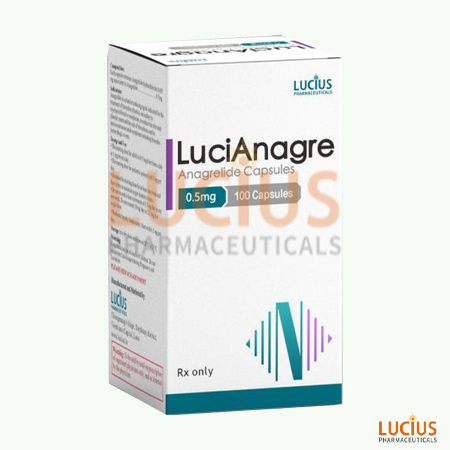



Another Name盐酸阿那格雷胶囊、安归宁、阿那格雷、Agrylin、Xagrid
IndicationsThrombocythemia
Reg No.08 L 1180/24
Inspection No.
dosage form:Capsule
Reference Price:$131
Specs:0.5mg*100capsules
Indate:24 months
Anagrelide is an effective drug for the treatment of thrombocythemia, but its use should be strictly followed by the doctor's instructions, with attention to dose adjustment and monitoring for adverse effects.
Patients should communicate regularly with their doctor during use to ensure the use of the drug.
Anagrelide is a medication used to treat thrombocythemia.
Anagrelide
Patients with thrombocythemia secondary to myeloproliferative neoplasms.
The available data obtained in the case reports did not identify the risk of drug-related significant birth defects, miscarriages, or adverse maternal and infant outcomes. In animal embryo-fetal studies, during organogenesis at approximately 97 times the maximum clinical dose (10 Fetal developmental delay (delayed ossification of bones and weight loss) is observed in rats administered at doses of anagrel hydrochloride in mg/day) (based on body surface area). Thrombocythemia of pregnancy has adverse effects on maternal and infant outcomes. For the population shown, the estimated background risk of major birth defects and miscarriage is unknown. All pregnancies have a background risk of birth defects, miscarriage, or other adverse outcomes. In the general population of the United States, the estimated background risk of major birth defects and miscarriage in clinically confirmed pregnancies was respectively 2% to 4% and 15% to 20%.
There is no information on the presence of anagregrel in human milk, its effects on breastfed children, or its effects on milk production. Anagrelide or its metabolites were detected in the milk of lactating rats. Because breastfed children may have serious adverse effects, including thrombocytopenia, it is recommended for patients Anagrelide Breastfeeding is not recommended during treatment and for a week after the last dose.
According to the results of animal studies, anagrel may impair fertility in women.
The safety and efficacy of anagrelide in pediatric patients 7 years of age and older has been demonstrated. There were no data for pediatric patients under 7 years of age. Anagre Its use in these pediatric patients is supported by evidence from adequate and well-controlled adult anagrelide studies, which also provided 18 patients aged 7 to 16 years with ET and pharmacokinetic, pharmacodynamic, and safety data in pediatric patients presenting with thrombocythemia. There was no clear trend or difference in the type of adverse events observed in pediatric patients compared to adult patients.
Of the 942 subjects in the anagrelide clinical study, 42.1% were 65 years and older, while 14.9% were 75 years and older. No overall differences in safety or efficacy were observed between these and younger participants, and other reported clinical experiences did not find a difference in response between older and younger patients, but it cannot be ruled out that some older people have higher sensitivity.
Hepatic metabolism is the main pathway for anagrel clearance. Anagrel exposure is increased 8-fold in patients with moderate hepatic insufficiency, requiring dose reduction. The use of anagrelide in patients with severe hepatic insufficiency has not been studied situation. Avoid the use of anagrelide in patients with severe hepatic insufficiency. The potential risks and benefits of treatment with anagrelide in patients with mild and moderate hepatic insufficiency should be assessed before initiating treatment. at Anagrelide Liver function was assessed before and during treatment.
It has been shown that anagrelide doses are higher than the recommended dose to cause hypotension. There have been reports of post-marketing cases of deliberate overdose Anagre. Reported symptoms include sinus tachycardia and vomiting. Symptoms are relieved with supportive care. A Anagre Treatment-induced thrombocytopenia is dose-dependent; As a result, an overdose may lead to thrombocytopenia, which can lead to bleeding. If you overdose, stop taking anagrelide, and monitor your platelet count for thrombocytopenia and watch for possible complications, such as bleeding. Once the platelet count returns to the normal range, consider resuming it Anagrelide.
Store at 25°C (77°F) with an offset to 15°C to 30°C (59°F to 86°F) allowed.
Dose proportions have been found in the dose range of 0.5 mg to 2.5 mg.
FDA,2021.10
Anagrelide is an important drug that plays an active role in clinical treatment. When used in combin···【more】
Recommended:712024-17-12
In the process of clinical treatment, the combination of drugs often leads to better efficacy. Howev···【more】
Recommended:782024-17-12
Thrombocythemia is a common blood disease that poses a serious threat to the health of patients. Cho···【more】
Recommended:802024-16-12
Thrombocythemia is a common blood disorder, and drug therapy is one of the common treatments. Among ···【more】
Recommended:742024-16-12
Anagrelide is a drug used to treat idiopathic thrombocythemia, and its price fluctuates with the mar···【more】
Recommended:732024-13-12
Anagrelide is a medication commonly used to treat idiopathic thrombocythemia. As one of the importan···【more】
Recommended:782024-13-12
In the current medical market, the price fluctuation of anagrelide as a drug used to treat diseases ···【more】
Recommended:792024-12-12
Anagrelide is a drug used to treat thrombocythemia, primarily for abnormal elevated platelet counts ···【more】
Recommended:772024-12-12

Lucius Pharmaceutical Co., Ltd., was established in 2020 in Vientiane, the capital of Laos. It aims to offer safe, effective, and affordable medicines globally. With a factory spanning 25,000 square meters, the company manufactures 200+ generic drugs in diverse therapeutic fields.
Address:No.26 Thongmang village, Xaythany district, Vientiane Capital, Laos
E-mail:laoslucius@gmail.com
Whatsapp: